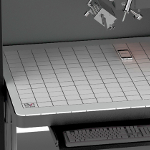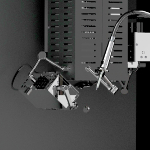EVISCAN is the first high-tech workstation to detect latent prints and trace evidence

Contactless
For more than 100 years, dactyloscopy is an indispensable aid in crime solving. Since the late 19th century, fingerprints are utilized as means of identification.
To detect and visualize latent traces, forensic investigators typically use a range of different techniques – including many relying on adhesives, chemicals and UV excitation. While such techniques can be highly effective, they require surfaces to be physically contacted in ways that ultimately can alter them.
Altering of substrates or fingerprints, in turn, can hinder the use of other forensic technologies such as touch DNA or future innovations in fingerprint analysis.
Non-contaminative and non-invasive

EVISCAN acquires latent trace evidence with neither physical contact nor use of chemicals. The unique lab workstation combines the latest detector technology with cutting-edge software for processing digital images.
Thus evidence remains available for all subsequent analyses, in its original condition and with its DNA material fully intact. And because no chemicals are involved, examinations do not endanger the health of the user.
Innovation for forensics

With EVISCAN, therefore, forensic investigators can examine objects thoroughly and still retain all other analysis options, thereby improving their chances to achieve an identification.
Further, because EVISCAN no longer requires the time-consuming sub-steps of pre-treatment, exposure time and photo documentation, it reduces total processing time from hours – or even days – to just minutes. The acquired digital trace images can be immediately transferred to fingerprint databanks (e. g. AFIS) and dactyloscopic identification.



